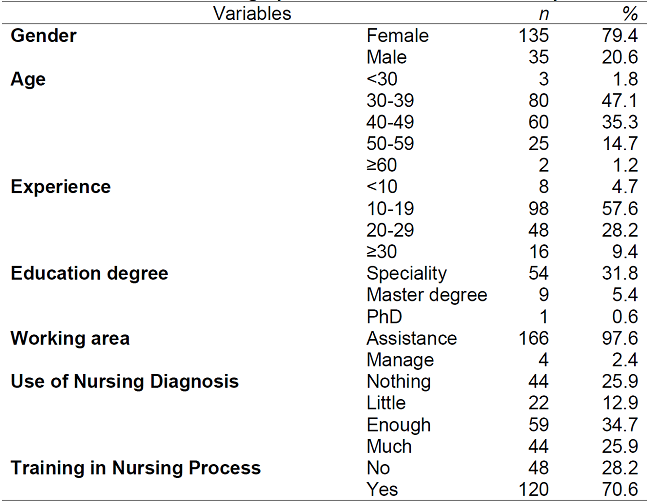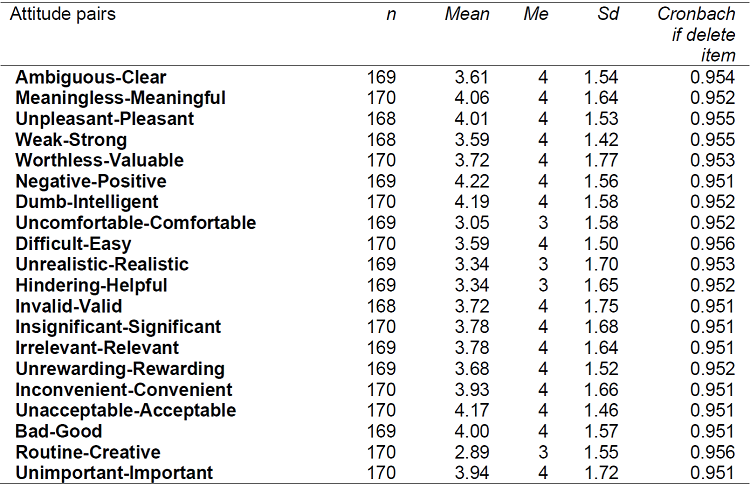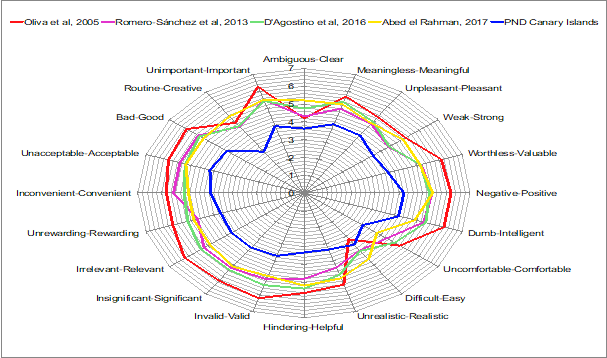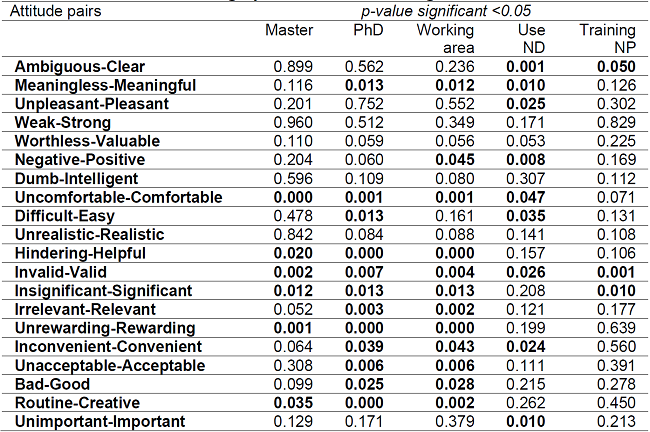Meu SciELO
Serviços Personalizados
Journal
Artigo
Indicadores
-
 Citado por SciELO
Citado por SciELO -
 Acessos
Acessos
Links relacionados
-
 Citado por Google
Citado por Google -
 Similares em
SciELO
Similares em
SciELO -
 Similares em Google
Similares em Google
Compartilhar
Enfermería Global
versão On-line ISSN 1695-6141
Enferm. glob. vol.21 no.67 Murcia Jul. 2022 Epub 19-Set-2022
https://dx.doi.org/10.6018/eglobal.492291
Originals
Attitudes towards Nursing Diagnosis: application of the Position on Nursing Diagnosis scale in Canary Islands
1aMaternal and Child Insular University Hospital Complex. Canary Health Service. Las Palmas. Canary Islands. Spain
1bNursing department. University of Las Palmas de Gran Canaria. Las Palmas. Canary Islands. Spain
2El Doctoral Health Center. Primary Care Management of Gran Canaria. Canary Health Service. Las Palmas. Canary Islands. Spain
3Faculty of Nursing. El Carmen Campus. University of Huelva. Huelva. Andalucía. Spain
Introduction:
Nurses have different opinions and attitudes about the clinical functionality of Nursing Diagnosis.
Method:
observational, descriptive, cross-sectional study in a hospital in the Canary Islands (Spain). Position on Nursing Diagnosis is a validated instrument to measure the attitudes of nurses towards the Nursing Diagnosis with excellent reliability. It is made up by a coded scale of 20 pairs of opposite adjectives in which the interviewed must position himself; extreme scores 1 (most negative attitude) and 7 (most positive attitude); 4 middle value; 140 maximum score and 20 minimum one. Reliability analysis was performed using Cronbach's alpha and inter-element correlation. Frequency distribution for qualitative variables and proportion for quantitative variables. Association analysis.
Results:
The study population was N=170. The scale has shown high reliability (α=0.955) as well as adequate power to explain the total variance (66.13%). The global mean score was 74.41 (sd=23.53); the worst attitude was Routine (µ=2.91; sd=1.55) while the best attitude was Positive (µ=4.20; sd=1.56).
Conclusions:
The attitudes of the nurses in our environment are similar to other contexts, with global scores lower than the average. The increase in academic training and the use of the Nursing Diagnosis in the work environment seem to improve the attitudes of this professionals, mainly with regard to acceptance, comfort, ease, relevance, validity, creativity and gratification.
Keywords: Nursing Diagnosis; Nursing Process; Classification; Attitude; Nurses
INTRODUCTION
The development of Nursing requires the creation of care models based on a disciplinary conception, in which the use of standardised languages, symbols and common concepts for clinical practice reinforce the potential, commitment, professional identity and quality of care provided to users and their families1. In this sense, Nursing actions require lifelong and integrative learning2in the face of highly flexible and multidisciplinary situations with a high multidisciplinary content that requires critical thinking and analytical skills; but also a mastery of very high level technical skills in which sensitivity must be maintained to provide care to individuals facing complex health-illness situations, which are the driving force behind the work, the focus of attention and the object of study of Nursing.
In addition, the healthcare models in our context are linked to a growing use of information systems, by means of applications that provide instruments to facilitate the Nursing Process (NP), as well as to evaluate professional activity. In this sense, there is a close relationship between the implementation of these computer applications and the normative development that regulates the contents of the patients' Clinical Records. For this process of standardising care, it is necessary to use a common language. In this area, Nursing Diagnosis (ND) are central elements; primarily because 70% of nurses' records are aligned with controlled languages, involving 40% of their time when they are documented on paper and 9% when they are done in electronic systems3.
Diagnostic competence involves a specific qualification and specific attributes linked to professional expertise through reflective practice, which is conducive to Nursing autonomy. Thus, Hasegawa et al.4evaluated the conceptual framework of possible factors influencing this diagnostic competence; these elements included clinical experience, decision-making responsibility, knowledge and attitude towards ND.
An attitude constitutes the personal position on a bipolar evaluative or affective dimension with respect to an object, action or event; it represents a favourable or unfavourable feeling5that relates the opinion and behaviour of these individuals, involving and indicating their willingness to affect and act6.
In this sense, the diagnostic stage is complex, promoting divergent and discrepant opinions7among professionals who express opposing perceptions about the clinical functionality of ND; it is necessary to establish a debate about their concepts and objectives, but also their values and paradigms. Although ND provide consistency, they have been considered to lack comprehensiveness and utility, which fosters inaccuracies3and restricts evidence8. Instead, they can be useful when they match the cognitive abilities of the professionals who use them9.
Knowing nurses' opinions on diagnostic taxonomies is essential to improve them10. Thus, Krenz & Lunney11developed Position on Nursing Diagnosis (PND), an instrument to measure the attitudes towards ND12.
Results from previous experiences suggest similar attitudes in the different contexts observed. Thus, in Brazil13they applied PND to a population N=81 (n=26 students and n=55 nurses), 61.8% of the nurses worked in the academic setting compared to 34.6% in the healthcare setting. The average total rating achieved with the PND was 111.3 points, which was a positive overall rating. The attitude with the highest score wasImportant(μ=6.3; sd=1.1) and the lowestDifficult(μ=3.2; sd=1.7). Again in Brazil14, on a sample N=398 (n=184 students and n=214 nurses), of which 68.4% were working in the care setting; the highest score wasImportant(μ=6.3; sd=1.1) and the lowestDifficult(μ=3.2; sd=1.7). A third application in the Brazilian context15to N=1605 professionals (n=632 nurses; n=973 assistants) showed mean total score 114.34; on that occasion, the best rated attitude corresponded toPositive(μ=6.32) and the worst toRoutine(μ=4.01).
In Spain16they applied the PND (α=0.96; r=0.90) to N=621 nurses, of whom 76.5% were women and 72.9% worked in the care setting. The sample indicated age μ=40.5 (sd=10.1), years of professional experience μ=17.1 (sd=10.4). In this occasion, the mean overall score was 98.6 points.
In India17the PND was applied through 2 measurements (pretest and posttest) in a study with educational intervention and control group to N=101 nurses from 2 hospitals. Their results showed no statistical significance in the pretest (μ=7.14; p=0.944); on the contrary, the differences in the mean improved in the second measurement, both in the control group (μ=8.38; p≤0.05) and in the intervention group (μ=25.8; p≤0.05), as well as when comparing the posttest measurements of both groups (μ=24.56; p≤0.05). This study concluded that as nurses' clinical skills progressed, their attitudes towards ND changed positively.
On the other hand, in Italy18they applied the PND to N=262 nurses, 60.7% women, age μ=37.7 (sd=8.18) years, professional experience μ=12.5 (sd=8.43) years; on this occasion, the best rated attitude wasImportant(μ=5.46; sd=1.61) and the worstDifficult(μ=4.02; sd=1.92).
Finally, in Jordan19they applied the PND to N=100 Nursing students with a mean total scale score of 100.50; the best rated attitude wasImportant(μ=5.51; sd=1.59); the worst wasUncomforTable(μ=3.79; sd=1.61).
In view of the above, the objective is to describe the attitudes of Nursing professionals towards ND in our context.
METHOD
Observational, descriptive, cross-sectional study using non-probabilistic sampling by quotas carried out during the months of February and March 2018. We included the target population of nurses (N=1032) in theMother and Child University Hospital(CHUIMI, in Spanish Complejo Hospitalario Universitario Insular Materno Infantil) (Canary Islands, Spain) who responded to the questionnaire voluntarily. No exclusion criteria were established. The source of information and measurement instrument used was the Spanish version of the PND (PND-SV®)16, after obtaining the author's permission for its use.
The PND has been validated and applied in different languages and cultural contexts, such as Brazil, India, Italy and Jordan13)(14)(15)(17)(18)(19. It has also been developed and applied in Spain16, also a reduced version of the questionnaire with 7 items has been implemented12.
The PND instrument is made up of 20 pairs of opposing adjectives (independent variables) in which the interviewee, using a Likert scale coded in 7 levels, must position themselves by selecting the one that fits their attitude towards the ND; the extreme scores avoid acquiescence bias with values between 1 and 7; 4 is the central value. For analysis, coding of the response items has been established in which the value 1 corresponds to the worst attitudes, while the value 7 corresponds to the best. The total scores of the PND scale vary between 20 and 140, mean score 80; Figures below this value would indicate negative attitudes. Seven questions were attached, assessing socio-demographic aspects of the population, such as: gender, age, years of professional experience, academic qualifications, area of work, use of ND in professional practice, training in the NP in the last 5 years (dependent variables). Anonymity, confidentiality and exclusive use of the data for the research were guaranteed, and therefore permission was requested and obtained from the healthcare ethics committee of the province of Las Palmas. The IBM® SPSS® Statistics software package (version 21.0.0.0) was used for data analysis. Reliability analysis was carried out using Cronbach's alpha coefficient and inter-item correlation. Descriptive analysis using frequency distributions for qualitative variables and proportions for quantitative variables, association analysis using correlation of variables of interest. The results have been expressed in Tables and explained in narrative form. The graphs have been elaborated with the help of Microsoft Excel 2011 for Mac, version 14.0.0. As a possible limitation to external validity, we should point out that the instrument was self-administered.
RESULTS
N=170 responses (16.47% of the target population). Women 79.4%, mean age 41.24 years (Me=40; sd=7.15). Mean professional experience 18.02 years (Me=17.00; sd=7.12). The working area was assistance 97.65% of the cases. Regarding academic training, 31.8% of the sample had a Nursing specialty, 5.4% had an official Master's degree and only 0.6% had PhD, the rest of the sociodemographic results are shown inTable 1.
The version of the PND applied showed high reliability (α=0.955) as well as adequate explanatory power of the total variance (66.13%) for the sample. The Pearson correlation was adequate, with bilateral significance (p<0.05) for a range of values between 0.820-0.190. The intraclass correlation coefficient performed with a two-factor mixed-effects model, in which the effects of the persons are random and the effects of the measures are fixed, was for the individual measures r=0.515 (CI=0.458-0.576; p=0.000) and for the average measures r=0.955 (CI=0.955-0.944; p=0.000).
Descriptive analysis showed mean global score 74.41 (sd=23.53). The majority of items presented scores close to the central value, the attitude with the lowest score corresponded toRoutine(µ=2.89; sd=1.55) while the best rated item wasPositive(µ=4.22; sd=1.56). The total mean scores, median and standard deviation, as well as Cronbach's Alpha assuming the elimination of one item are shown inTable 2.
Graphic 1shows (blue line) the total scores after application of the PND in our setting, compared to previous applications in other contexts.
After the normality test using the Kolmogorov-Smirnov test (p=0.000), Spearman's Rho non-parametric correlation was performed for each of the scales; all of them showed bilateral significance in the interval 0.806-0.166.
In the analysis of association, Chi-square showed no statistical significance for gender, age, experience and speciality in Nursing. On the other hand, there was statistical significance (p<0.05) in the assumptions of postgraduate degree, official Master's or PhD, work environment, use of the ND and NP training, as shown inTable 3.
DISCUSSION
PND has been used with both Nursing students and professionals. In this sense, students show more positive attitudes towards the ND13,19. However, our interest lies in finding out about these attitudes among professionals.
Previously, the PND has been applied on 7 occasions and in 5 different countries between 2005 and 2017. Brazil, with 3 experiences, is the context with the highest number of times; while in Spain, the present study is the second application of the 20-item version, although a reduced version of 7 items has also been applied, both in 2013. No applications of the PND have been identified in other countries, which could be of vital importance to complete the world map of the positioning of nurses in relation to the ND in environments as distant as North America, Asia, Anglo-Saxon and even Central Europe, with a prominent role in the panorama of the development of the Nursing discipline.
The scores achieved in the different applications of the PND can be observed comparatively (Graphic 1), showing that the attitudes towards the ND among the individuals in our study (blue line) are lower than those achieved in previous applications. In general, the different investigations show a tendency to reproduce the mean values for most of the attitudes, mainly the worst and best rated ones.
In our study, it can be observed that the progress of positive attitudes towards the ND is related to an increase in postgraduate university education and the regular use of the ND in health systems by nurses, which provides improvements in clinical reasoning skills among these professionals20. In this sense, nurses improve mainly in relation to the acceptance, comfort and ease of the ND, giving them above all greater relevance, validity, creativity and gratification.
In Spain, the application of an abridged version12of the instrument makes it possible to continue research in this line in a simplified manner, with a 7-item scale that has also demonstrated high reliability; however, for our study it was considered of greater interest to apply the broad version of the PND in order to make comparisons with the international contexts described above.
Among the limitations of the study, it should be taken into account that these opinions or attitudes vary according to the different professional profiles that make up the sample; in this order, a recent international study21has concluded the need to categorise professionals in order to establish, through the determination of clusters, appropriate strategies to improve results.
CONCLUSIONS
The attitudes shown by nurses in our environment are similar to other realities, although with overall scores below the average in most attitudes. This generalisation of the international positioning towards the ND seems to indicate that the difficulties derived from its use are not only due to conditioning factors of the immediate environment; it is possible that there are other circumstances linked to the idiosyncrasy of the ND as a product, but also as a process. Increased academic training and its use in the work environment seem to improve professional attitudes towards ND, mainly in terms of acceptance, comfort, ease, relevance, validity, creativity and gratification.
In-depth studies are needed to identify the real difficulties that generate these attitudes, as well as to determine strategies for their improvement. In this sense, it is proposed to optimise the cognitive alignment of ND with professional competences, review the conceptual adequacy of diagnostic classifications with the disciplinary metaparadigm, promote training processes that favour critical thinking skills and evaluate the use made of ND in health systems.
Acknowledgment
We are grateful to Dr. José Manuel Romero Sánchez for authorising the rights to use the Position on Nursing Diagnosis-Spanish Version (PND-SV) scale.
REFERENCES
1. Zarate Grajales RA. La Gestión del Cuidado de Enfermería. Index de Enfermería [Internet]. 2004 [citado 11 de febrero de 2018];13(44-45):42-6. Disponible en: http://scielo.isciii.es/scielo.php?script=sci_arttext&pid=S1132-12962004000100009 [ Links ]
2. Gómez Beltrán PA. Análisis comparado de la percepción de competencias en estudiantes de enfermería en relación con el entorno en Andalucía occidental y el Algarve portugués [Internet]. (Tesis Doctoral). Universidad de Huelva, Huelva, España; 2017 [citado 10 de septiembre de 2018]. Disponible en: http://rabida.uhu.es/dspace/handle/10272/15037 [ Links ]
3. Carrington JM. The effectiveness of electronic health record with standardized nursing languages for communicating patient status related to a clinical event. [Internet]. (Tesis Doctoral). University of Arizona, Arizona, USA.; 2008 [citado 12 de febrero de 2016]. Disponible en: https://repository.arizona.edu/handle/10150/195397 [ Links ]
4. Hasegawa T, Ogasawara C, Katz EC. Measuring Diagnostic Competency and the Analysis of Factors Influencing Competency Using Written Case Studies. Int J Nurs Terminol Classif [Internet]. 1 de julio de 2007 [citado 29 de marzo de 2017];18(3):93-102. Disponible en: http://doi.wiley.com/10.1111/j.1744-618X.2007.00057.x [ Links ]
5. Rodríguez LR. La Teoría De Acción Razonada : Implicaciones Para El Estudio De Las Actitudes. Investig Educ Duranguense. 2007;(7):66-77. Disponible en: http://www.upd.edu.mx/PDF/Revistas/InvestigacionEducativaDuranguense7.pdf [ Links ]
6. Silva CR, Lima E de FA, Furieri LB, Primo CC, Fioresi M. Nurses' attitudes toward the nursing process. Rev Pesqui Cuid é Fundam Online [Internet]. 4 de octubre de 2018 [citado 1 de diciembre de 2018];10(4):1111-7. Disponible en: http://seer.unirio.br/index.php/cuidadofundamental/article/view/6339 [ Links ]
7. De Queiroz Frazão CMF, De Sá JD, De Paiva M das GMN, De Carvalho Lira ALB, De Oliveira Lopes MV, Enders BC. Association Between Nursing Diagnoses and Socioeconomic/Clinical Characteristics of Patients on Hemodialysis. Int J Nurs Knowl [Internet]. 1 de julio de 2015 [citado 28 de octubre de 2016];26(3):135-40. Disponible en: http://doi.wiley.com/10.1111/2047-3095.12051 [ Links ]
8. Powers P. A Discourse Analysis of Nursing Diagnosis. Qual Health Res [Internet]. septiembre de 2002 [citado 2 de noviembre de 2016];12(7):945-65. Disponible en: https://doi.org/10.1177%2F104973202129120377 [ Links ]
9. Cho I, Park H. Evaluation of the Expressiveness of an ICNP-based Nursing Data Dictionary in a Computerized Nursing Record System. J Am Med Informatics Assoc [Internet]. 1 de julio de 2006 [citado 18 de noviembre de 2016];13(4):456-64. Disponible en: https://academic.oup.com/jamia/article-lookup/doi/10.1197/jamia.M1982 [ Links ]
10. Elizalde A, Almeida M. Percepções de enfermeiras de um hospital universitário sobre a implantação dos diagnósticos de enfermagem. Rev gau´cha Enferm [Internet]. 2006 [citado 31 de octubre de 2016];27(4):564-74. Disponible en: http://www.lume.ufrgs.br/handle/10183/23572 [ Links ]
11. Krenz M, Lunney M. A tool that measures attitudes toward nursing diagnosis. Carroll-Johnson R, Paquette M, editores. Nurs Diagn. enero de 1992;3(1):44. Disponible en: https://doi.org/10.1111/j.1744-618X.1992.tb00199.x [ Links ]
12. Romero-Sánchez JM, Paloma-Castro O, Paramio-Cuevas JC, Pastor-Montero SM, O'Ferrall-González C, Gabaldón-Bravo EM, et al. Desarrollo y evaluación psicométrica de una forma abreviada de la escala de posicionamiento ante el diagnóstico enfermero. Rev da Esc Enferm da USP [Internet]. junio de 2013 [citado 20 de julio de 2016];47(3):591-9. Disponible en: https://doi.org/10.1590/S0080-623420130000300010 [ Links ]
13. Oliva APV, Lopes D de A, Volpato MP, Hayashi AAM. Atitudes de alunos e enfermeiros frente ao diagnóstico de enfermagem. Acta Paul Enferm [Internet]. diciembre de 2005 [citado 11 de febrero de 2018];18(4):361-7. Disponible en: http://www.scielo.br/scielo.php?script=sci_arttext&pid=S0103-21002005000400004&lng=pt&tlng=pt [ Links ]
14. Cruz D de ALM da, Hayashi AAM, Oliva APV, Corrêa CG. Adaptação e validação do instrumento "Positions on nursing diagnosis" para a língua portuguesa. Rev Bras Enferm [Internet]. abril de 2006 [citado 2 de enero de 2020];59(2):163-7. Disponible en: http://www.scielo.br/scielo.php?script=sci_arttext&pid=S0034-71672006000200008&lng=pt&tlng=pt [ Links ]
15. Guedes E de S, Sousa RMC de, Turrini RNT, Baltar VT, Cruz D de ALM da. Adaptation and validation of the instrument positions on the nursing process. Rev Lat Am Enfermagem [Internet]. febrero de 2013 [citado 12 de febrero de 2018];21(1):404-11. Disponible en: http://www.scielo.br/scielo.php?script=sci_arttext&pid=S0104-11692013000100016&lng=en&tlng=en [ Links ]
16. Romero-Sánchez JM, Paramio-Cuevas JC, Paloma-Castro O, Pastor-Montero SM, O'Ferrall-González C, Gabaldón-Bravo EM, et al. The Spanish version of the Position on Nursing Diagnosis scale: cross-cultural adaptation and psychometric assessment. J Adv Nurs [Internet]. diciembre de 2013 [citado 20 de julio de 2016];69(12):2759-71. Disponible en: http://doi.wiley.com/10.1111/jan.12128 [ Links ]
17. Collins A. Effect of Continuing Nursing Education on Nurses' Attitude Toward and Accuracy of Nursing Diagnosis. Int J Nurs Knowl [Internet]. 1 de mayo de 2013 [citado 11 de febrero de 2018];24(3):122-8. Disponible en: http://doi.wiley.com/10.1111/j.2047-3095.2013.01237.x [ Links ]
18. D'Agostino F, Vellone E, Cerro E, Di Sarra L, Juárez-Vela R, Ghezzi V, et al. Psychometric evaluation of the Positions on Nursing Diagnosis scale. Appl Nurs Res [Internet]. febrero de 2016 [citado 31 de octubre de 2016];29:e1-6. Disponible en: http://linkinghub.elsevier.com/retrieve/pii/S0897189715000725 [ Links ]
19. Abed El-Rahman M, Al Kalaldeh MT, Malak MZ. Perceptions and Attitudes Toward NANDA-I Nursing Diagnoses: A Cross-Sectional Study of Jordanian Nursing Students. Int J Nurs Knowl [Internet]. enero de 2017 [citado 24 de octubre de 2016];28(1):13-8. Disponible en: http://doi.wiley.com/10.1111/2047-3095.12100 [ Links ]
20. Müller-Staub M, Lavin MA, Needham I, van Achterberg T. Nursing diagnoses, interventions and outcomes ? application and impact on nursing practice: systematic review. J Adv Nurs [Internet]. diciembre de 2006 [citado 26 de marzo de 2017];56(5):514-31. Disponible en: http://doi.wiley.com/10.1111/j.1365-2648.2006.04012.x [ Links ]
21. D'Agostino F, Pancani L, Romero-Sánchez JM, Lumillo-Gutierrez I, Paloma-Castro O, Vellone E, et al. Nurses' beliefs about nursing diagnosis: A study with cluster analysis. J Adv Nurs [Internet]. 8 de junio de 2018 [citado 21 de febrero de 2018];74(6):1359-70. Disponible en: http://doi.wiley.com/10.1111/jan.1354 [ Links ]
Received: September 17, 2021; Accepted: December 18, 2021











 texto em
texto em 






